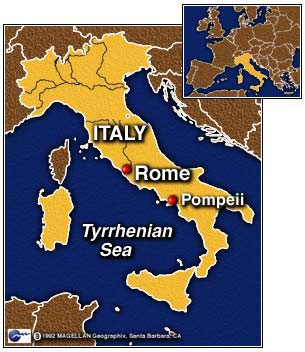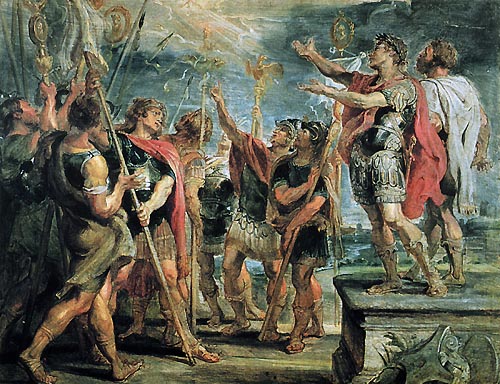The city of Pompeii was an ancient city located in southern Italy southeast of Naples. It was founded in the sixth or early fifth century B.C., and was a Roman colony by 80 B.C. It became a prosperous port and resort with many noted villas, temples, theaters, and baths. The city was under the dictatorship of Lucius Cornelius Sulla. It was a favorite resort for wealthy Romans, reaching a population of about 20,000 at the beginning of the Christian era. It was also a place of considerable trade and was the port town of Nola and other inland cities of the fertile valley of the Sarnies.

Pompeii was damaged by and earthquake in 63 A.D., but the city would encounter much more than this in its coming years.
On August 24, 79 A.D. Mount Vesuvius blew up and tons of molten ash, pumice and sulfuric gas miles into the atmosphere. The poisonous vapors and molten debris suffocated the inhabitants of Pompeii and the near by cities of Herculaneum and Stabiae. Tons of falling debris filled the streets until nothing remained to be seen of the once thriving communities. The cities remained buried and undiscovered for almost 1700 years until excavation began in 1748.

In a second letter to Tacitus, Pliny describes what happened to him and to his mother during the second day of the disaster: "Ashes were already falling, not as yet very thickly. I looked round: a dense black cloud was coming up behind us, spreading over the earth like a flood.'Let us leave the road while we can still see,'I said,'or we shall be knocked down and trampled underfoot in the dark by the crowd behind.'We had scarcely sat down to rest when darkness fell, not the dark of a moonless or cloudy night, but as if the lamp had been put out in a closed room.
You could hear the shrieks of women, the wailing of infants, and the shouting of men; some were calling their parents, others their children or their wives, trying to recognize them by their voices. People bewailed their own fate or that of their relatives, and there were some who prayed for death in their terror of dying. Many besought the aid of the gods, but still more imagined there were no gods left, and that the universe was plunged into eternal darkness for evermore.

There were people, too, who added to the real perils by inventing fictitious dangers: some reported that part of Misenum had collapsed or another part was on fire, and though their tales were false they found others to believe them. A gleam of light returned, but we took this to be a warning of the approaching flames rather than daylight. However, the flames remained some distance off; then darkness came on once more and ashes began to fall again, this time in heavy showers. We rose from time to time and shook them off, otherwise we should have been buried and crushed beneath their weight. I could boast that not a groan or cry of fear escaped me in these perils, but I admit that I derived some poor consolation in my mortal lot from the belief that the whole world was dying with me and I with it."
Archaeologists began excavating Pompeii during the 18th century. Here they found the remains of people, ancient buildings, and other artifacts preserved amid the volcanic debris. Among the structures uncovered was The Forum of Pompeii. (McIntosh 29)
The ash mixed with rain, settled around the volcano’s victims, creating molds. These molds remained intact long after the bodies had decayed. Archaeologists pour liquid plaster into the forms, preserving the exact shapes of the bodies at the moment of death. (Place, 28)
Since that fateful day there have been subsequent eruptions that have reshaped the mountain. They occurred about every 100 years until 1037. On the 16th December 1631, a major eruption destroyed all the towns that had grown at the foot of the mountain. Over the next 300 years there were 23 eruptions of various degrees. The last known eruption was in 1944 when the Allied forces were attacking Italy. The volcano bubbles and smokes yet today. With modern technology, the people living in the area should be given adequate warning prior to any future eruption. Property will be damaged but lives can be saved.
Place, Robin. Bodies From the Past. Thomson Learning, New York, 1995.
McIntosh, Jane. Archeology. Alfred A. Knopf, Inc., New York, 1994.



